Rebel Wisdom Podcast Transcript – Interview with Jordan Hall
Research Focus
“If you want to go fast, go alone. If you want to go far, go together.”
– African Proverb
Research Question: “How can we improve the way we work together on hard problems?”
How parents behave changes how kids behave. How governments behave changes the behavior of other governments. In both situations, what’s going on is complex and it’s constantly changing.
So how do we thrive within complex adaptive systems?
Three complex adaptive system challenges are worth highlighting:
• Complexity. Complex adaptive systems have multiple, dynamic variables which influence system behavior.
• Finding Feedback. Many of the most important signals can be difficult to detect.
• Avoiding Information Overload. With complex adaptive system there is often an abundance of conflicting information.
Collaboration (I.e. people working together) provides a path to thriving within complex adaptive systems. Improvement in three specific areas can significantly improve collaboration:
• Understanding Brains. Specifically, understanding how our brains filter information and link information to action.
• Understanding Groups. Specifically, understanding how groups share information and focus effort.
• Developing Messages. Specifically, improving how people communicate to work together on hard problems.
People have been working together for thousands of years, but collaboration can still be difficult, especially when working on dynamic, complex problems. Three specific challenges involved with working with people are:
• Behavior vs Information. Changing behavior (defined as action driven by information and the environment) involves more than just providing new information. As Derek Sivers says, “If all we needed was information, we’d all be millionaires with six-pack abs.”
• Message vs Messenger. As humans, we tend to focus more on our feelings about the person delivering the message as opposed to what they’re actually saying.
• Emotional vs. Rational Individuals. We like to think we’re all rational. In reality, we all lean heavily on hormones (I.e. emotions) to navigate complex issues. In addition to being emotional, each of us has a unique view of a shared world.
Going in to 2022, I’m focused on three things:
• Organized Beliefs. Knowledge pyramids & reference triangles (ways to pre-organize information in order to rapidly orient to unexpected events).
• Communication. How do people communicate? What do people communicate? What’s the best way to share information? What’s the best way to rapidly develop common context to work with others?
• Organizations. What are different ways groups organize? Which ways work better? Why? How do groups adapt and improve?
PMM – The Brain
(PMM = Picturing Mental Models. A “mental model” is a way to think about something)
I have three pictures I use for a practical “theory of mind”:
1) A Junction Box
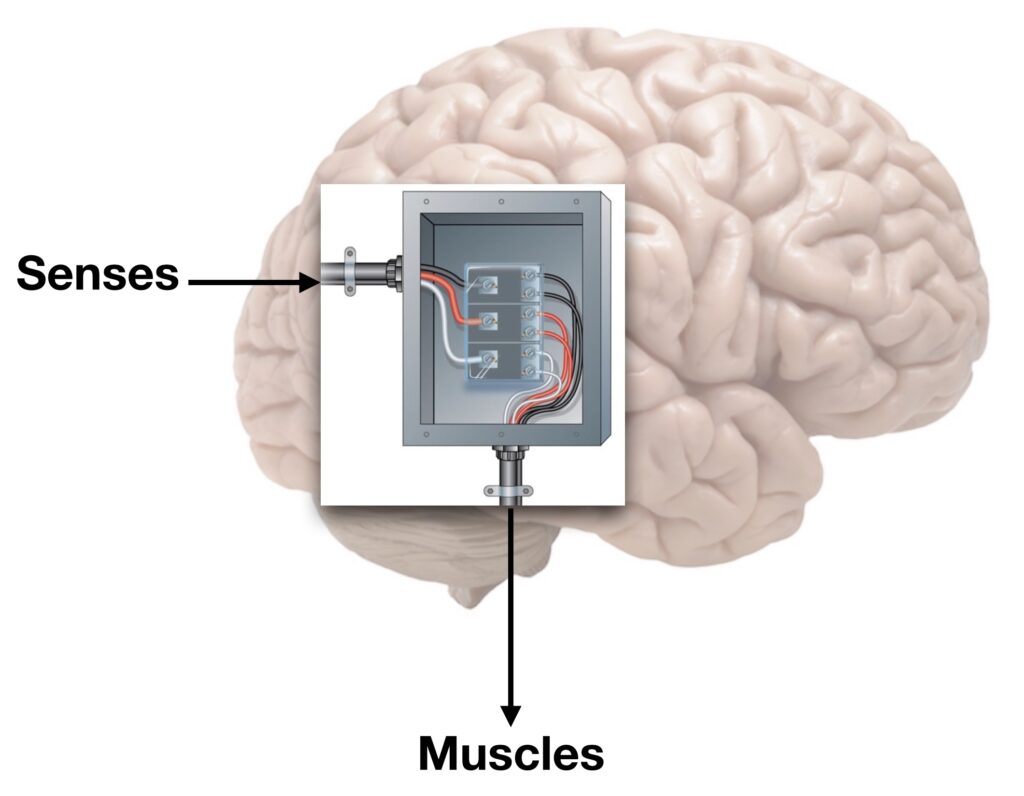
The brain is like a junction box, it links the senses with thoughts (other neurons firing), actions (neurons firing to contract muscles) and emotions (neurons firing to release hormones).
2) An Iceberg
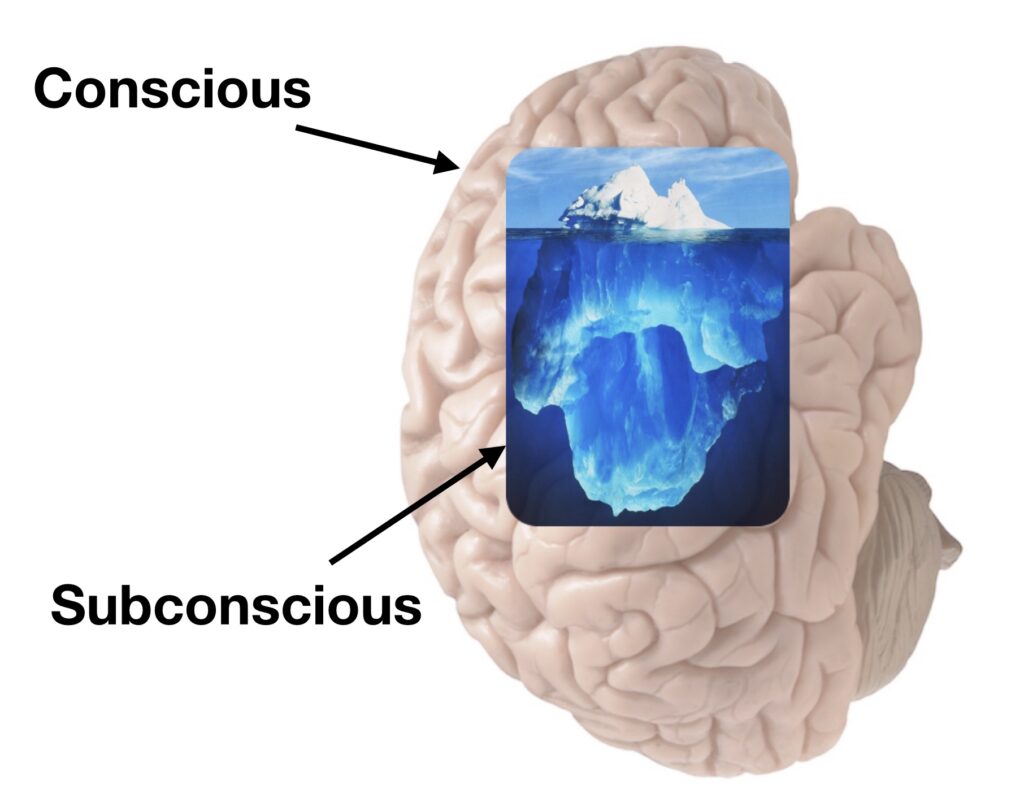
The brain is like an iceberg. Most of the activity is below the surface.
We’re not aware of most of the signaling going on inside our heads.
There is a ton of information from sensory cells which is constantly being filtered out and happening below our conscious level of awareness.
3) Rain Chains

This one is subtle, but powerful. In many ways it expands on the idea of the iceberg.
Neurons are like a rain chain. Rain chains channel water from gutters on the roof to the ground. Neurons channel sensations into thoughts, emotions and actions.
Here’s a picture of a fancy rain chain made of watering cans which makes the the concept a little easier to see:

With the watering can rain chain, water flow is slowed down, which makes it easier to visualize a couple interesting aspects:
- The water coming out of the spouts is a collection of water from all across the roof. Likewise, our actions, thoughts and emotions are generated by a dynamic mix of sensations (a bunch of individual neurons firing).
- Water continues to flow out of the bottom of the rain chain after the rain stops hitting the roof. Likewise, we can have thoughts, actions and emotions which are disconnected from the initial trigger.
These three pictures provide the foundation for 1st principles which I’ve found extremely useful when it comes to learning and performance:
- The brain does two things: it filters and it links.
- At any given moment there is a finite amount of energy available in the brain to fire neurons.
- At any given moment I’m only aware of a small part of what’s going on in my head.
With these 1st principles in mind, I’ve found it helpful to simplify learning as a process of tuning filters and growing links. My filters determine what captures my attention and my beliefs are stored as links between information.
LFP (Learning For Performance) Pyramids
Getting from “Oh no!” to “Aha!” to “Done!”
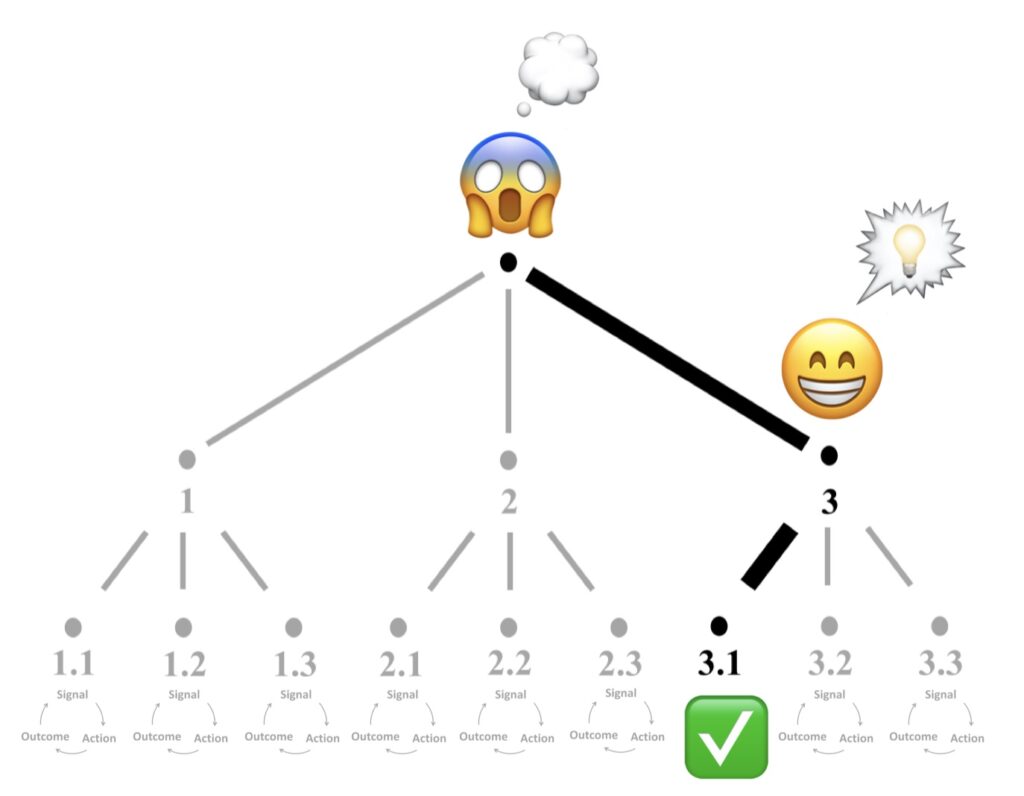
“To attain knowledge, add things every day. To attain wisdom, remove things everyday.”
-Lao Tzu
The Rules:
1) Define Terms
2) Make Choices
The LFP system is designed for one purpose: to link information to action to outcome under pressure.
Knowledge, wisdom and skill are all different things:

- Knowledge is an understanding of how information links together.
- Wisdom is an understanding of what information is relevant to a specific context.
- Skill is the ability to link a signal to an action in time to produce an intended outcome.
Deciding on an action is context dependent.
The process of building a framework and then making conscious decisions about how you are going to link together your beliefs is what makes a LFP pyramid useful. It’s deceptively simple and remarkably powerful.
A common approach to a complex, uncertain future is to try and predict a range of different possibilities:
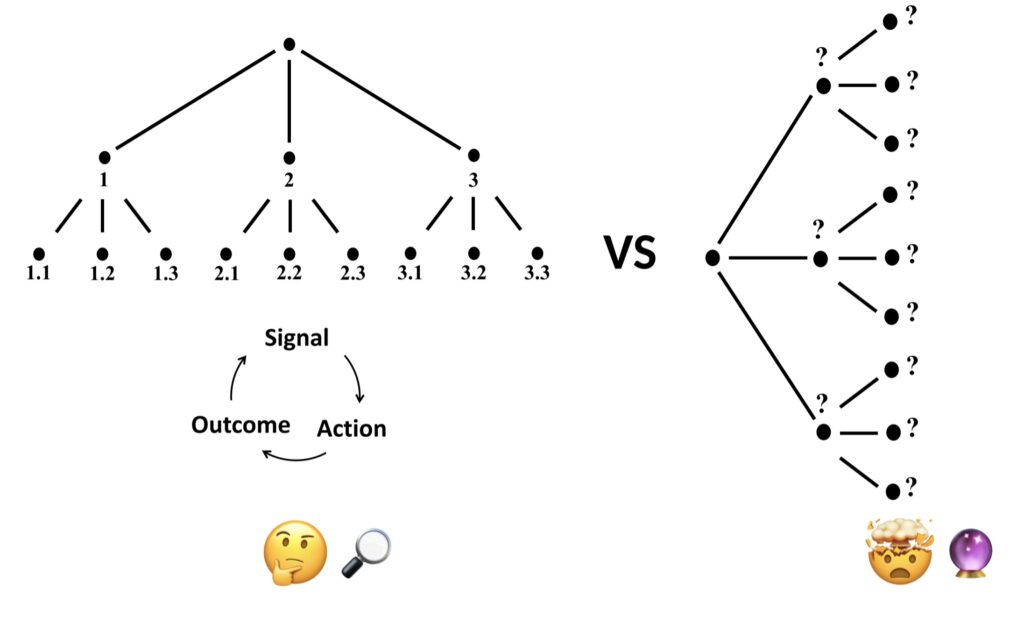
LFP is a fundamentally different approach.
Time is spent:
- Identifying useful signals.
- Identifying actions where a little effort can dramatically influence a system (i.e. leverage).
- Understanding the relationships between signals, actions and outcomes within systems.
The pyramid structure is intentional and a critical part of LFP.
- It starts with a single entry point.
- The pyramid branches down to a foundation of feedback loops.
- Each branch point has a maximum of three branches.
Improving your pyramid as you learn is where the choices come in.
It takes work to define terms and then choose where they go in the structure.
The definitions and choices are critical pieces of the process. The constraints of definitions and choices are where the practical learning takes place.
The definitions and choices are a way to learn for performance, to learn with the intent of linking specific information to specific actions to generate specific outcomes.
Here are the first three levels of the framework I’ve been using for learning about how our bodies work, how we think and how we relate to each other:
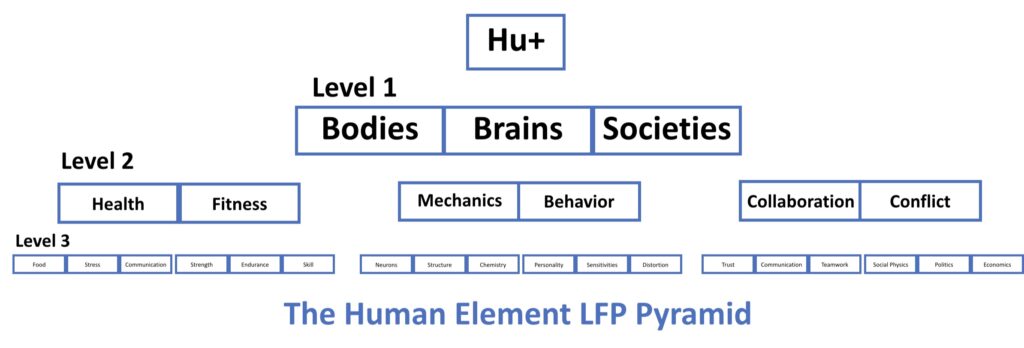
Here’s a little different view of the same information to make it easier to read:
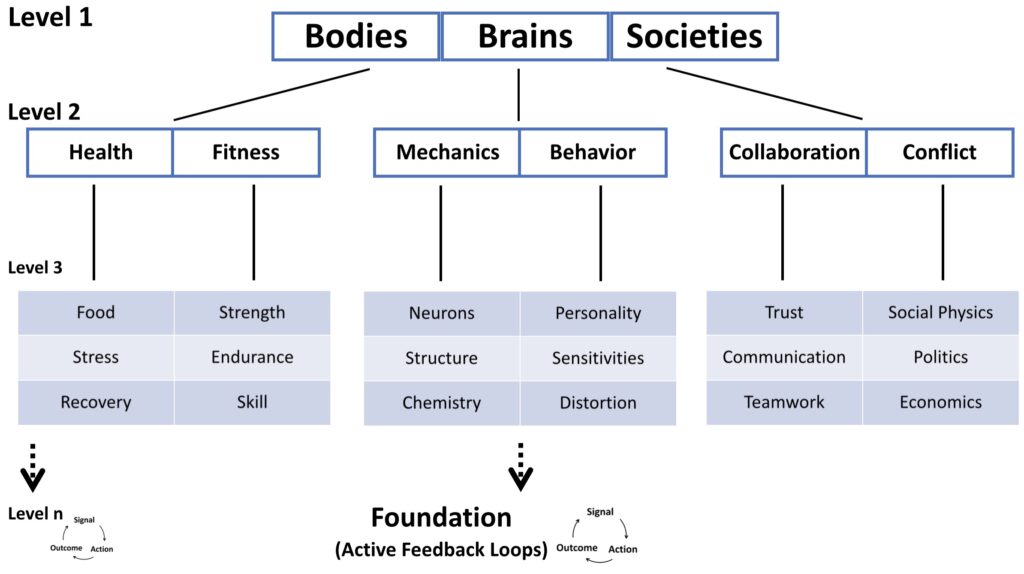
Circling back to where we started, the purpose of the LFP Pyramid is to link information to action to outcome under pressure.
The picture above is just the top three layers of the LFP pyramid I use.
As an example, level 4 for “food” branches to digestion, inflammation and energy. I’m sensitive to the signals I’ll get from eating specific things like sugar and seed oils. I eat 2-3 times a day every day so I’ve got active feedback loops linking the foods I eat to how they impact digestion, inflammation and energy.
Just like your reaction to specific foods will be different than mine, the terms you use for your LFP pyramid will probably be different than the terms I chose.
Spending time building a framework which ties broad but vague terms like “health” or “fitness” or “politics” or “economics” with specific signals linked to specific actions and outcomes is how a LFP pyramid will help you get from “Oh no!” to “Aha!” to “Done!”
Thanks for reading. You can find out more about my background: here.
If this approach resonates with you, I highly recommend two books:
The Art of the Long View by Peter Schwartz, which provides a practical, easy to follow, step-by-step process for strategic planning within complex systems.
Thinking in Systems: A Primer by Donella Meadows is by far the best book I’ve found on systems thinking.
Articles
From Surfing to Strategy
Our brains are amazing
https://medium.com/the-human-element/from-surfing-to-strategy-2b697500c411
Who’s Listening?
Three questions for improving conversations.
https://medium.com/the-human-element/im-listening-7c70da72a36a
Improving Understanding
An approach to the challenges of understanding our beliefs and the beliefs of others.
https://medium.com/the-human-element/improving-understanding-e21c56e1eaae
Great American Diet Experiment
A deep look at the 2015 dietary guidelines and how the guidelines shape health.
https://medium.com/the-human-element/the-great-american-diet-experiment-cd29f746792
This I Believe – December 2021
Updated: December 29, 2021
“If you want to go fast, go alone; if you want to go far, go together.”
-African Proverb
I believe happiness comes from growth (learning new things) and collaboration (working hard with others).
I believe to survive and thrive we have to adapt. I believe to adapt we have to communicate and collaborate.
I believe the biggest challenge for our society at this moment in time is communication.
I believe the challenges in communicating are impacting economics, education, healthcare and politics.
Communication. I believe the increase in available information has made communication more challenging. As individuals, we’re only exposed to a portion of the story and we each have different filters for the limited information we have available. More individual digital information and less shared physical experience (and the feedback it provides) means less common knowledge to build conversations from. I believe communication will improve as we develop a deeper understanding of how we form beliefs, filter information and communicate.
Collaboration. I believe working with others to make things better is essential to mental health and happiness. I believe the current information paradox we’re experiencing (where we have access to more individual information but less shared information) makes it harder to collaborate. I’m optimistic about collaboration improving because working with others is an innate desire for the majority of the population.
Economics (Livelihood / Employment). I believe the risk involved with working for (most) large organizations continues to increase. I believe the main drivers of the increasing risk are the pursuit of automation and a priority of short term profit over contribution. I believe blockchain technology (distributed ledgers, smart contracts and Decentralized Autonomous Organizations (DAOs)) will radically transform businesses, starting with the financial industry. I believe the opportunity associated with sharing well understood personal talent continues to improve. I believe the ability to work with others and provide value is essential to mental health and happiness. I believe our innate desire to work with others will continue to lead to new opportunities.
Education. I believe the cost of college education continues to increase while the value of a college education continues to fall. I believe the current trajectory is unsustainable. I believe education (as opposed to the credentialing process applied by gatekeepers) will improve because the methods of learning and the tools for learning are improving at an exponential rate. I believe the demand for education will increase as more of us are required to learn more new skills more often. I believe blockchain technology (distributed ledgers) will shift value away from diplomas and credentials and towards portfolios (i.e. demonstrated capabilities).
Healthcare. COVID-19 exposed deep flaws in the current US healthcare system. Specifically, the current system is based on a business funded by the treatment of symptoms as opposed to establishing and maintaining health. On the promising side, the practice of functional medicine (restoring and maintaining the basic functioning of the body) continues to improve and spread.
Politics. I believe uncertainty is driving more people to the extremes of the political spectrum, autocratic rule on the right and socialism on the left. I believe the far right is more inclined to use violence and support the use of violence to suppress the left while the far left is more inclined to use social pressure and support the use of social pressure to suppress the right. I believe communication is being blocked at both extremes and that both approaches are bad for adapting to a changing world. I believe politics is one area where the increase in available information will help us. I believe that as we learn more about how communities, societies and nations can communicate and collaborate we’ll improve the system. I believe governing is best when it’s something done with the people, not for the people or to the people.
2020 Journal
19 OCT
Onlyness – gathering and incorporating ideas / information
Blueprint – Unity of effort [Team of Teams]
31 AUG
As FiveThirtyEight’s Nate Silver wrote, “There is a lot of ‘the pendulum is swinging away from Biden’ speculation based on rather little actual evidence.”
The pioneering psychologists Amos Tversky and Daniel Kahneman came up with an idea decades ago that explains the rush to declare a Trump surge: availability.
The idea of availability is that people assess the likelihood of an event occurring based on how easy it is to imagine. And that often leads to errors.
Since Trump won a comeback victory in the most recent presidential election, it’s very easy to imagine him doing so again. The possibility is highly availableto our brains.
- Large-scale protests against President Aleksandr Lukashenko of Belarus, the country’s longtime authoritarian leader, entered their fourth week. “People have gotten tired of everything and stopped being afraid,” one demonstrator said.
- The U.S. has passed six million confirmed coronavirus cases. (Here’s a map with the latest figures nationwide.)
- In New York, the absence of widely available rapid virus tests has led affluent New Yorkers to turn to services that can yield results in as little as 24 hours. Free standard tests can take days to return results.
- The Times’s Rukmini Callimachi has reported the largely untold story of what happened the night police killed Breonna Taylor in a botched drug raid.
- In his latest media column, The Times’s Ben Smith examines the long shadow of a 1996 magazine story on race by the prominent journalist Andrew Sullivan
https://www.washingtonpost.com/opinions/2020/08/30/its-time-challenge-cockeyed-reaction-violence/
https://www.washingtonpost.com/politics/trump-coronavirus-scott-atlas-herd-immunity/2020/08/30/925e68fe-e93b-11ea-970a-64c73a1c2392_story.html
Atlas, who does not have a background in infectious diseases or epidemiology, has expanded his influence inside the White House by advocating policies that appeal to Trump’s desire to move past the pandemic and get the economy going, distressing health officials on the White House coronavirus task force and throughout the administration who worry that their advice is being followed less and less.
Atlas has fashioned himself as the “anti-Dr. Fauci,” one senior administration official said
Medium – Google’s Genius $49/mo Course Is About to Replace College Degrees “In our own hiring, we will now treat these new career certificates as the equivalent of a four-year degree for related roles.”
https://entrepreneurshandbook.co/googles-genius-49-mo-course-is-about-to-replace-college-degrees-340f459aaa9b
WSJ – 31 AUG – Silicon Valley start-up. Amazon for farmers. Taking on big agriculture.
WSJ – 28 AUG – IRS – Payroll tax deferment guidance to employers. [what happens to the social security trust?]
WSJ – 28 AUG – Pentagon is pulling out 1/3 of remaining troops in Iraq. Leaving 3,500.
WSJ – 28 AUG – Chinese drug maker in talks with countries for emergency vaccine approval before completion of clinical trials.
WSJ – 28 AUG – RNC Convention wrap-up
NYT – 28 Aug ? – Two P.R. Experts at the FDA have been removed after the fiasco over convalescent plasma.
WSJ – 27 AUG – NBA – playoffs – voting centers
WSJ – 27 AUG – WH – $750B deal with Abbott on testing [impact to the testing ecosystem + limited ability of others to get non-WH directed supplies – central control of resources w/o coordinated plan.
Kenosha WI
LIF – Human Performance
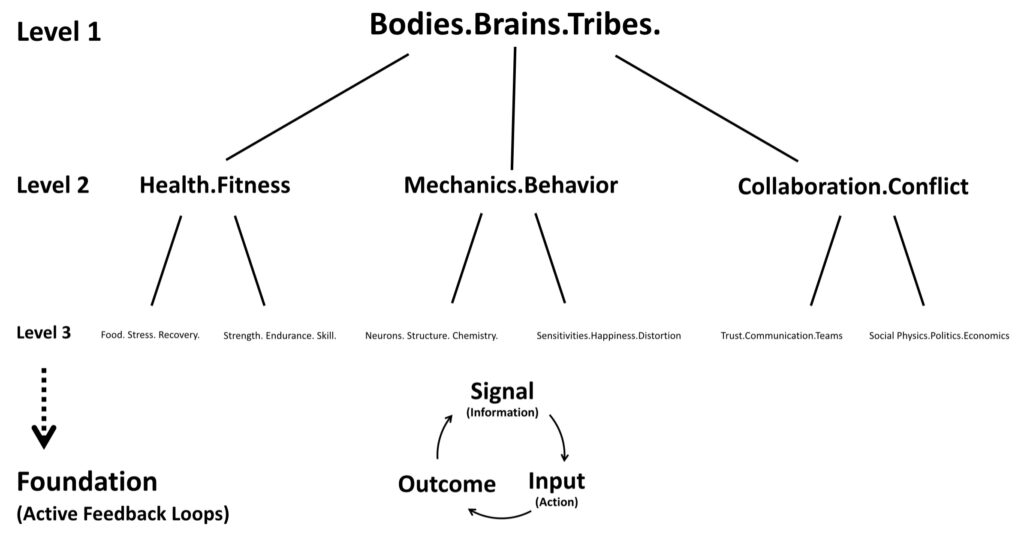
Layer 1 – 1 Bodies 2 Brains 3 Tribes
Bodies
Bodies Layer 2 – 1.1 Health 1.2 Fitness
1.1 Health
Working Definition: How well the body works.
Health Level 3 – 1.1.1 Food 1.1.2 Stress 1.1.3 Recovery
Health Level 4 (Food): 1.1.1.1 Look 1.1.1.2 Feel 1.1.1.3 Perform
Health Level 5 – 1.1.1.1 Look: Skin (clarity) and Body Composition (amount of fat and where it’s stored.
Skin clarity is an indicator of immune function.
Body composition / Fat storage (how much and where) is an indicator of how much load is being placed on the thyroid, liver and pancreas and how well they are working.
1.1.1.2 Feel: Hunger & Digestion
Hunger (when, how often, how much) is an indicator of blood sugar levels and patterns.
Digestion (how your stomach feels and the type, frequency and experience of poops) is an indicator of how well your digestive system is working (and proper function is essential for both getting nutrients out of food and as a protective barrier against pathogens).
1.1.1.3 Perform
Level 4 – Stress: 1.1.2.1 Physical. 1.1.2.2 Mental. 1.1.2.3 Emotional
Level 4 – Recovery: 1.1.3.1 Physical. 1.1.3.2 Mental. 1.1.3.3 Emotional
Brains
Layer 2 – 2.1 Brain Mechanics. 2.2 Behavior
Layer 3 – 2.1.1 Neurons. 2.1.2 Structure 2.1.3 Chemistry
Layer 3 – 2.2.1 Sensitivities. 2.2.2 Happiness 2.2.3 Distortion
Layer 4 (Sensitivities) – 2.2.1.1 Social Cues (roles, responsibilities, relationships, talent and character). 2.2.1.2 Effort (resources, risk, rewards)
Layer 4 (Happiness) – 2.2.2.1 Collaboration. 2.2.2.2 Growth (Improvement / Learning)
Layer 4 (Distortion) – 2.2.3.1 Pathos (distorting how bad things are). 2.2.3.2 Ethos (distorting how good things could be). 2.2.3.3 Logos (distorting the path from bad to good (how hard, how easy or an understanding of what the steps are). 2.2.3.4 Kairos (distorting opportunity (what can be done) and / or timing (when it can be done or when it must be done).
Tribes
Layer 2 – 3.1 Collaboration. 3.2 Conflict
Layer 3 – 3.1.1 Trust. 3.1.2 Communication. 3.1.3 Teams
Layer 3 – 3.2.1 Social Physics. 3.2.1 Politics. 3.2.2 Economics
Tech
Notes on tech
https://singularityhub.com/2020/07/29/what-if-cars-could-read-and-react-to-your-emotions-soon-they-will/
Senses
https://www.wsj.com/articles/different-wavelengths-science-finds-hummingbirds-see-ultraviolet-light-invisible-to-humans-11594688179
